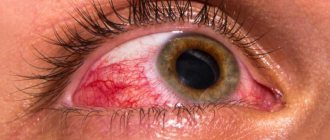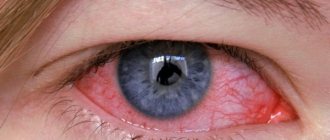Symptoms of the disease in children
- Profuse lacrimation,
- Itching in the area of infection,
- Irritation from bright light
- Swelling of the eyelids,
- Formation of a film on the eyes,
- Purulent discharge (in the case of a bacterial form of the disease),
- There may be pinpoint hemorrhages.
Let's take a closer look
- Bacterial (chlamydia, Staphylococcus aureus, Pseudomonas aeruginosa, pneumococci, etc.) Characteristic signs are sticking of the eyelids, dryness in the eye area and conjunctiva. First, the infection appears on one eye, then on the other.
- Allergic. Accompanied by sneezing, secretion of clear fluid, with the desire to rub the infected area.
- Viral (adenoviruses, herpesviruses, ARVI). Abundant, clear fluid appears on the eye, without sticking of the eyelids. Characterized by a runny nose, sore throat and fever. Just like with a bacterial infection, the infection first appears in one eye.
- Drug. The symptoms are similar to allergic conjunctivitis and occur several hours after instillation of the solution to prevent infection.
- Fungal. Reminds me of a bacterial one. It happens that the eyes are affected by a mixed infection.
Conjunctivitis in infants: causes
Infection can occur for a number of reasons:
- Contact with the mother's mucous membrane, during childbirth,
- Reduced immunity in the baby,
- Failure to comply with hygiene procedures,
- Infection from doctors
- Presence of a foreign body in the eye,
- Infection in the mother's body.
A woman who is carrying a child must take care of the baby’s health in advance and treat all existing diseases. The nature, duration, and treatment of the infection will depend on its type (bacterial or viral).
Return to contents
Causes of conjunctivitis
Most often, newborns experience bacterial and viral conjunctivitis, which is caused by bacteria and viruses.
There are two main ways of contracting this disease: airborne and household (through contact with a sick person or his things). If the disease occurs in the maternity hospital, then it is most likely that the infection occurred during childbirth or due to insufficient compliance by medical staff with measures to ensure sterility. Bacterial conjunctivitis is caused by Staphylococcus aureus and Staphylococcus epidermidis, Streptococcus, Escherichia coli and Pseudomonas aeruginosa, Gonococcus, a transitional form of microorganisms between bacteria and viruses - chlamydia. Viral conjunctivitis is most often provoked by the herpes simplex virus. The causative agents of bacterial and viral conjunctivitis can act both separately and together. The most easily treatable bacterial conjunctivitis is caused by staphylococci.
In addition to bacterial and viral infections, conjunctivitis can be caused by:
- increased pathogenicity of the eye's own microflora;
- allergic reactions;
- physical or chemical irritation of the eyes (foreign body, tobacco smoke, etc.).
Diagnosis of conjunctivitis in newborns
An ophthalmologist is excellent at recognizing the diagnosis of a disease in an infant. In case of a purulent form, he takes a smear, with the help of which he determines the type of infection. But here it is very important to exclude meibomitis, since the treatment methods in this case will be different. If the form of the disease is allergic, allergy tests are performed.
Depending on the test results obtained, treatment is prescribed. The affected area is washed with a solution of furatsilin using a gauze swab or a syringe without a needle. If the infection is accompanied by pain and fever, the baby is given an antipyretic and analgesic drug intravenously.
What is conjunctivitis like?
Depending on the cause of occurrence, conjunctivitis is divided into types:
Bacterial infections, they are also called purulent. The disease is accompanied by copious thick discharge and is poorly tolerated by infants. At first it affects only one eye, the inflammation spreads to the second after a couple of days. Despite its severe course, the disease can be successfully treated and has virtually no complications. The only exception is gonoblennorrhea.
- The most common bacterial infection in infants is chlamydia; it accounts for 40% of all cases of conjunctivitis in the first month of life. Eye inflammation develops in 25-50% of babies born to women with acute infection. Symptoms of conjunctivitis appear after 2, maximum 4 weeks, in premature babies - faster. The disease occurs in an acute form, in the absence of treatment - with periods of exacerbation and temporary attenuation. If not treated in a timely manner, respiratory tract infection and otitis media may occur. The infection is accompanied by intoxication, so the baby may develop a fever, lethargy, and a headache.
- Pneumococcus and Haemophilus influenzae cause 30-50% of cases of conjunctivitis. Different strains of pneumococci differ in their pathogenicity, so the disease can have several forms. Newborns are characterized by a tear-like form - against the background of redness of the eyes, liquid tear-mucous discharge comes out of them. In older children, the discharge is usually purulent.
- Haemophilus influenzae is one of the representatives of normal microflora, can be transmitted by airborne droplets, and is an opportunistic microorganism. Its excessive development is possible in premature newborns, as well as in babies taking antibacterial medications for a long time. Those at risk include bottle-fed children, weakened infants, and those who have just had an illness.
- Gonococcus accounts for less than 1% of infections. This microorganism leads to the development of acute purulent conjunctivitis - gonoblennorrhea. Infection occurs during childbirth if the mother has gonorrhea. Symptoms appear around day 2. If treatment is started in a timely manner, the prognosis is good and the infant’s vision can be preserved. If the infection has managed to affect the cornea of the eye, complications are possible in the form of deterioration of vision, including blindness. Prevention of gonoblennorrhea is carried out immediately after birth. The newborn's eyes are wiped with a solution of furatsilin and rivanol, and sodium sulfacyl is instilled.
Chemically caused conjunctivitis usually occurs as a consequence of local antigonococcal prophylaxis. It appears on the first day and disappears on its own in 2-4 days.
Viral conjunctivitis in a newborn is much less common and is usually caused by adenoviruses. Infection occurs through contact with a sick person, symptoms appear after 4-7 days. Usually only 1 eye is affected, the second either remains healthy or is affected in a milder form after a couple of days. Usually conjunctivitis is preceded by ARVI. Herpes infection is also possible in children. This conjunctivitis does not go away for a long time and has a gradual course. Any viral infection can be complicated by a bacterial infection with its characteristic symptoms, which makes it very difficult to identify the true cause of the pathology.
The cause of allergic conjunctivitis is hypersensitivity to allergens. As a rule, it is accompanied by rhinitis, urticaria, and atopic dermatitis. It is not typical for newborns; it is usually observed in children over 4 years of age.
Treatment of eye infection in an infant
With a quick response and the right approach to treatment, conjunctivitis can be overcome in 2 days. The problem is that not all forms of infection control are suitable for an infant.
Depending on the type of conjunctivitis, treatment is divided into the following stages:
Bacterial
- Floxal (the main component is ofloxacin). Can be used from birth, 1-4 drops per day.
- Tobrex (active substance - tobramycin). Infants - 1-2 drops 5 times a day. For children 6 months of age and older - every 4 hours.
- Levomycetin. Not recommended for children under 2 years of age. 1 drop is instilled into the conjunctival sac once every 5 hours.
- Tsipromed (active substance - ciprofloxacin). Not recommended for children under 1 year of age. 1-2 drops are administered 6 times a day.
It is recommended to apply ointment at night. For very small children - “Floxal” (with a substance concentration of 1%). Please note that albucid (sodium sulfacyl) is available in 20% and 30% solutions. Usually, instillation is accompanied by a strong burning sensation, so this drug is not recommended for use at the beginning of treatment.
If the infection has acquired a purulent form, before instillation, wash the eyes with chamomile infusion at room temperature, and also apply antibacterial ointment (tetracycline or erythromycin) at night.
| It should be remembered: only the doctor who diagnosed the form of the disease prescribes treatment. It is important to adhere to the recommendations, whether it is an inexpensive method of treatment or vice versa. |
- Ophthalmoferon (based on alpha-2b recombinant interferon). Used for newborns. The drug contains boric acid and diphenhydramine, which provide an anti-inflammatory effect.
- Actipol (para-aminobenzoic acid) The effect of the drug has not been studied, so it is recommended to use it when the benefit outweighs the possible risk. It must be stored in the refrigerator and warmed to room temperature before instillation.
Also, viral conjunctivitis can be treated with chamomile infusion (1 teaspoon per glass of boiling water) or weak tea.
Allergic
- Cromohexal (cromoglicic acid) is recommended for children over 2 years old, but with caution.
- Opatanol (generic name: olopatadine). Approved from the age of 3 years, but clinical trials have not been conducted on children.
- Allergodil (azelastine hydrochloride) is approved from 4 years.
If you suspect an allergic form of the disease, give him, for example, fenistil in drops for oral administration, be sure to visit a pediatrician and, if necessary, an allergist.
Return to contents
Treatment
Bacterial eye disease in infants requires a comprehensive approach.
Therapy is carried out in several stages:
- Constantly rinse the conjunctival cavity with antibacterial agents for the purpose of cleansing.
- Instillation with special anesthetic solutions that reduce sensitivity to bright light.
- The use of ointments and drops with an antibacterial effect.
Only the doctor who diagnosed the disease prescribes treatment. Independent selection of medications is strictly prohibited. General therapy is practiced only for widespread inflammatory processes.
Scheme for eye drops for a baby:
- The first 6 days of the disease - instillation of drops every 3-4 hours.
- The next 4 days - instill in 5-6 hours.
- Until recovery – in 12–18 hours.
When treating with eye ointments, they are applied behind the eyelid before bedtime 2-3 times a day.
The disease can be completely eliminated only by removing discharge from the eyes. For this purpose, rinsing with a solution of furatsilin or potassium permanganate is prescribed. The child's eyes should always be open. That is, you cannot tie them or apply compresses, so as not to create a favorable environment for the growth of bacteria.
Depending on the severity of the disease and its nature, the newborn will be treated in a hospital or at home. This is decided only by the leading doctor.
If parents suspect the development of conjunctivitis in a newborn, traditional medicine can help cope with the disease. It should be remembered that such treatment can only be complementary and cannot replace drug therapy.
The following will help relieve symptoms:
- washing the eyes with chamomile decoction;
- removal of purulent discharge with a swab dipped in tea;
- wiping with furatsilin solution.
It is important to remember that rinsing is done from the outer edge of the eye to the inner corner, with an individual swab used on each side.
Treatment of conjunctivitis in infants with folk remedies
Alternative medicine is not recommended for newborn babies, since mothers simply will not allow traditional methods of combating the disease to be tested on their child. Treatment of infants at home is also subject to criticism from modern medicine, since:
- For allergic conjunctivitis, the use of folk remedies may lead to an exacerbation of symptoms.
- In case of bacterial infection, some techniques, for example, instillation of breast milk, have the opposite effect of treatment.
- If the disease is viral in nature, non-traditional remedies act according to the faith of the patient.
However, there is an acceptable area of application of traditional medicine - the treatment of mucous membranes. Thus, it is useful to supplement the therapy prescribed by the doctor, and only after his approval.
Possible remedies: infusion of chamomile, cornflower, tea or aloe.
Directions for use: the finished medication is soaked in cotton-gauze swabs and used for mechanical treatment of the conjunctiva of the eye.
Complications and consequences
| Possible consequences of the disease in infants born prematurely: otitis media, meningitis, sepsis. This disease should be taken seriously. |
Main complications in infants:
- Decreased tear production or dry eye syndrome. Formed due to blockade of the corresponding tubules.
- Infectious inflammation of the eyelids or blepharitis. A concomitant consequence of conjunctivitis.
- Keratitis, episcleritis or deterioration of transparency in the cornea of the eye, the appearance of a cataract and other pathologies. May be caused by certain bacteria.
- Scarring of the tissue layer and mucous membrane of the eye. Usually caused by lack of necessary therapy.
Prevention of conjunctivitis in a newborn
To protect your child from infection as much as possible, you need to follow simple hygiene rules.
- Wash your baby's hands regularly, for example, after walking outside. Initially, accustom the child to cleanliness,
- Monitor the cleanliness of bedding, toys and other items of constant use,
- Spend as much time outdoors as possible
- Wash food thoroughly before use,
- Monitor baby food, it should be balanced and complete,
- Ventilate the nursery periodically and monitor the humidity level,
- Carry out bath procedures every day,
- Avoid contact with infected children.
Doctors at antenatal clinics deal with issues of hygiene and prevention. Depending on the mother’s condition, medications for treatment are recommended and the necessary procedures are carried out. Return to contents
Prevention
To prevent the occurrence of conjunctivitis in newborns, it is important to observe hygiene measures both in caring for the child and in the case of parents. Many infectious diseases, especially sexually transmitted diseases, pose a real threat to the health of the baby, therefore, in antenatal clinics, pregnant women are required to be tested for STIs.
A woman should promptly treat such diseases and avoid them in the future. If indicated, before giving birth, the woman undergoes disinfection of the birth canal, and the child undergoes preventive eye treatment.
In a maternity hospital, treatment of a newborn’s visual organs is a mandatory daily procedure. After discharge, mothers should carry out similar activities at home, following the advice of the doctor. But, if she notices any abnormalities, the child should be shown to a doctor as soon as possible.
Advice from professionals
- Even if symptoms appear in one eye, use both
- It is important to monitor the expiration date of medications
- Drop the medicine into your baby's inner corner, between the eyelids, even if he closes his eyes. When he opens his eyes, the medicine will go where it is needed,
- When instilling drops into your baby’s eye, do not touch it with the pipette, otherwise it will become infected.
- During acute illness, instill the medicine frequently during the day and apply the ointment at night. During this period, conjunctivitis is characterized by profuse lacrimation, which stops the effect of the medication after half an hour,
- Continue treatment for another 3 days if all symptoms have passed.











